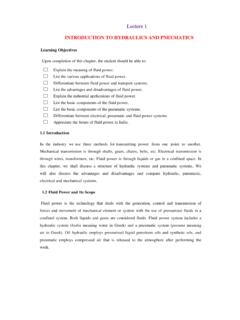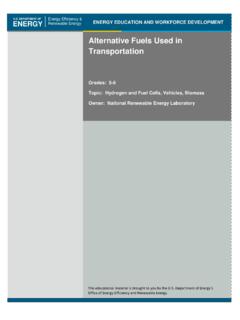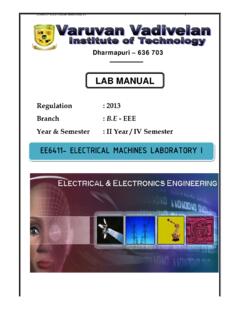Transcription of Module 3: Architecture of Hybrid and Electric Vehicles
1 NPTEL Electrical Engineering Introduction to Hybrid and Electric Vehicles Module 3: Architecture of Hybrid and Electric Vehicles Lecture 5: Basic Architecture of Hybrid Drive Trains and Analysis of Series Drive Train Basic Architecture of Hybrid Drive Trains and Analysis of Series Drive Train Introduction The topics covered in this chapter are as follows: Hybrid Electric Vehicles (HEV). Energy use in conventional Vehicles Energy saving potential of Hybrid drive trains Various HEV configurations and their operation modes The Hybrid Electric vehicle (HEV). What exactly is an HEV? The definition available is so general that it anticipates future technologies of energy sources. The term Hybrid vehicle refers to a vehicle with at least two sources of power. A Hybrid - Electric vehicle indicates that one source of power is provided by an Electric motor. The other source of motive power can come from a number of different technologies, but is typically provided by an internal combustion engine designed to run on either gasoline or diesel fuel.
2 As proposed by Technical Committee ( Electric Road Vehicles ) of the International Electrotechnical Commission, an HEV is a vehicle in which propulsion energy is available from two or more types of energy sources and at least one of them can deliver electrical energy. Based on this general definition, there are many types of HEVs, such as: the gasoline ICE and battery diesel ICE and battery battery and FC. battery and capacitor battery and flywheel battery and battery hybrids. Joint initiative of IITs and IISc Funded by MHRD Page 1 of 43. NPTEL Electrical Engineering Introduction to Hybrid and Electric Vehicles Most commonly, the propulsion force in HEV is provided by a combination of Electric motor and an ICE. The Electric motor is used to improve the energy efficiency (improves fuel consumption) and vehicular emissions while the ICE provides extended range capability. Energy Use in Conventional Vehicles In order to understand how a HEV may save energy, it is necessary first to examine how conventional Vehicles use energy.
3 The breakdown of energy use in a vehicle is as follows: In order to maintain movement, Vehicles must produce power at the wheels to overcome: a. aerodynamic drag (air friction on the body surfaces of the vehicle , coupled with pressure forces caused by the air flow). b. rolling resistance (the resistive forces between tires and the road surface). b. resistive gravity forces associated with climbing a grade Further, to accelerate, the vehicle must its inertia. Most of the energy expended in acceleration is then lost as heat in the brakes when the vehicle is brought to a stop. The vehicle must provide power for accessories such as heating fan, lights, power steering, and air conditioning. Finally, a vehicle will need to be capable of delivering power for acceleration with very little delay when the driver depresses the accelerator, which may necessitate keeping the power source in a standby (energy-using) mode.
4 A conventional engine-driven vehicle uses its engine to translate fuel energy into shaft power, directing most of this power through the drivetrain to turn the wheels. Much of the heat generated by combustion cannot be used for work and is wasted, both because heat engines have theoretical efficiency limit. Moreover, it is impossible to reach the theoretical efficiency limit because: some heat is lost through cylinder walls before it can do work some fuel is burned at less than the highest possible pressure fuel is also burned while the engine is experiencing negative load (during braking) or when the vehicle is coasting or at a stop, with the engine idling. Although part of engine losses would occur under any circumstances, part occurs because in conventional drivetrains, engines are sized to provide very high levels of Joint initiative of IITs and IISc Funded by MHRD Page 2 of 43.
5 NPTEL Electrical Engineering Introduction to Hybrid and Electric Vehicles peak power for the acceleration capability expected by consumers, about 10 times the power required to cruise at 100Km/h. However, the engines are operated at most times at a small fraction of peak power and at these operating points they are quite inefficient. Having such a large engine also increases the amount of fuel needed to keep the engine operating when the vehicle is stopped or during braking or coasting, and increases losses due to the added weight of the engine, which increases rolling resistance and inertial losses. Even gradeability requirements (example: 55 mph up a grade) require only about 60 or 70% of the power needed to accelerate from 0 to 100Km/h in under 12 seconds. The Figure 1 shows the translation of fuel energy into work at the wheels for a typical midsize vehicle in urban and highway driving.
6 From Figure 1 it can be observed that: At best, only 20% of the fuel energy reaches the wheels and is available to overcome the tractive forces, and this is on the highway when idling losses are at a minimum, braking loss is infrequent, and shifting is far less frequent. Braking and idling losses are extremely high in urban driving and even higher in more congested driving, , within urban cores during rush hour. Braking loss represents 46% of all tractive losses in urban driving. Idling losses represent about one sixth of the fuel energy on this cycle. Losses to aerodynamic drag, a fifth or less of tractive losses in urban driving, are more than half of the tractive losses during highway driving. Figure 1:Translation of fuel energy into work in a vehicle Joint initiative of IITs and IISc Funded by MHRD Page 3 of 43. NPTEL Electrical Engineering Introduction to Hybrid and Electric Vehicles Energy Savings Potential of Hybrid Drivetrains In terms of overall energy efficiency, the conceptual advantages of a Hybrid over a conventional vehicle are: Regenerative braking.
7 A Hybrid can capture some of the energy normally lost as heat to the mechanical brakes by using its Electric drive motor(s) in generator mode to brake the vehicle More efficient operation of the ICE, including reduction of idle. A Hybrid can avoid some of the energy losses associated with engine operation at speed and load combinations where the engine is inefficient by using the energy storage device to either absorb part of the ICE's output or augment it or even substitute for it. This allows the ICE to operate only at speeds and loads where it is most efficient. When an HEV is stopped, rather than running the engine at idle, where it is extremely inefficient, the control system may either shut off the engine, with the storage device providing auxiliary power (for heating or cooling the vehicle interior, powering headlights, etc.), or run the engine at a higher-than-idle (more efficient) power setting and use the excess power (over auxiliary loads) to recharge the storage device.
8 When the vehicle control system can shut the engine off at idle, the drivetrain can be designed so that the drive motor also serves as the starter motor, allowing extremely rapid restart due to the motor's high starting torque. Smaller ICE: Since the storage device can take up a part of the load, the HEV's ICE can be down sized. The ICE may be sized for the continuous load and not for the very high short term acceleration load. This enables the ICE to operate at a higher fraction of its rated power, generally at higher fuel efficiency, during most of the driving. There are counterbalancing factors reducing hybrids' energy advantage, including: Potential for higher weight. Although the fuel-driven energy source on a Hybrid generally will be of lower power and weight than the engine in a conventional vehicle of similar performance, total Hybrid weight is likely to be higher than the conventional vehicle it replaces because of the added weight of the storage device, Electric motor(s), and other components.
9 This depends, of course, on the storage mechanism chosen, the vehicle performance requirements, and so forth. Joint initiative of IITs and IISc Funded by MHRD Page 4 of 43. NPTEL Electrical Engineering Introduction to Hybrid and Electric Vehicles Electrical losses. Although individual Electric drivetrain components tend to be quite efficient for one-way energy flows, in many Hybrid configurations, electricity flows back and forth through components in a way that leads to cascading losses. Further, some of the components may be forced to operate under conditions where they have reduced efficiency. For example, like ICEs, most Electric motors have lower efficiency at the low-speed, low-load conditions often encountered in city driving. Without careful component selection and a control strategy that minimizes Electric losses, much of the theoretical efficiency advantage often associated with an Electric drivetrain can be lost.
10 HEV Configurations In Figure 2 the generic concept of a Hybrid drivetrain and possible energy flow route is shown. The various possible ways of combining the power flow to meet the driving requirements are: i. powertrain 1 alone delivers power ii. powertrain 2 alone delivers power iii. both powertrain 1 and 2 deliver power to load at the same time iv. powertrain 2 obtains power from load (regenerative braking). v. powertrain 2 obtains power from powertrain 1. vi. powertrain 2 obtains power from powertrain 1 and load at the same time vii. powertrain 1 delivers power simultaneously to load and to powertrain 2. viii. powertrain 1 delivers power to powertrain 2 and powertrain 2 delivers power ton load ix. powertrain 1 delivers power to load and load delivers power to powertrain 2. Joint initiative of IITs and IISc Funded by MHRD Page 5 of 43. NPTEL Electrical Engineering Introduction to Hybrid and Electric Vehicles Figure 2:Generic Hybrid Drivetrain [1].














